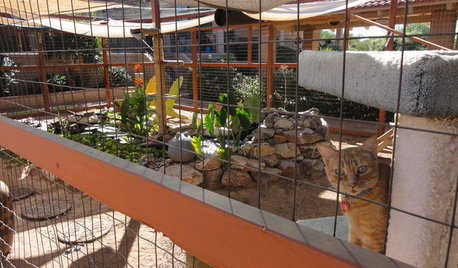Monster chickens
sushipup1
10 years ago
Related Stories

FENCES AND GATESA Deer Fence Can Be Decorative as Well as Protective
You need a monster-size fence to shelter your garden from deer, but it doesn’t have to look like a monstrosity
Full Story
PETSWorld of Design: Pampered Pets and Their 10 One-of-a-Kind Homes
Fall in love with these critters and their clever living spaces, from a cat playground in France to a chicken house in the U.S.
Full Story
PETSSee a Deluxe 'Catio' Built for Feline Fun
Sixteen lucky cats get the run of a protected outdoor patio with ramps, steps and even a koi pond
Full Story
PETSThe Best of My Houzz: 50 Design-Loving Pets
Share in the animal love with snapshots of adorable furry friends from our My Houzz series
Full Story
THE HARDWORKING HOMESmart Ways to Make the Most of a Compact Kitchen
Minimal square footage is no barrier to fulfilling your culinary dreams. These tips will help you squeeze the most out of your space
Full Story
MOST POPULARShould You Keep Your Tub?
There are reasons to have a bathtub, and plenty of reasons not to. Here’s how to decide if you should keep yours or pull the plug
Full Story
KITCHEN APPLIANCESConsidering a New Kitchen Gadget? Read This First
Save money, time and space by learning to separate the helpers from the hassles
Full Story
FUN HOUZZSurvey Says: We’re Scared of Being Home Alone — and Spiders
A new Houzz survey reveals that most of us get spooked in an empty house. Find out what’s causing the heebie-jeebies
Full Story
FUN HOUZZHow to Survive an Epidemic of Walking Dead
Tips to use around the house and garden to prep for the zombie apocalypse
Full Story
FUN HOUZZHouzz Quiz: What Style of House Should You Live In?
Does your heart belong to midcentury, traditional, farmhouse or something else? Take our quiz to find out
Full Story



annie1992
alex9179
Related Discussions
Monster damaged Lotus
Q
Monster Vine ID
Q
Donnie Darko Monster Rabbit has destroyed my Lincoln...
Q
BIG Green Monster & Meet Scooter! lol!
Q
annie1992
sushipup1Original Author
annie1992
teresa_nc7
foodonastump
JoanEileen
ryseryse_2004
mustangs81
dcarch7 d c f l a s h 7 @ y a h o o . c o m
alex9179
mitchdesj
dcarch7 d c f l a s h 7 @ y a h o o . c o m
arley_gw
alex9179
ryseryse_2004
dcarch7 d c f l a s h 7 @ y a h o o . c o m
foodonastump
dcarch7 d c f l a s h 7 @ y a h o o . c o m
ryseryse_2004
mitchdesj
foodonastump
arley_gw
John Liu
arley_gw
Jasdip
Jasdip
arley_gw
dcarch7 d c f l a s h 7 @ y a h o o . c o m
foodonastump
annie1992
bellsmom
zzackey
User
sunnibel7 Md 7
arley_gw
sunnibel7 Md 7
annie1992
sunnibel7 Md 7
Lars
ryseryse_2004
anoriginal
sleevendog (5a NY 6aNYC NL CA)
bellsmom
strawchicago z5
annie1992
sunnibel7 Md 7